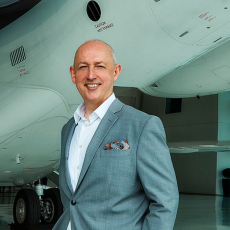You joined Bombardier more than three decades ago. How have you seen the company changing during this time, and how do you project its development into the future?
So much has changed in terms of technology and technology enablement in aircraft design during this time. Our products have transitioned from having independent segmented systems — pressure, mechanical, and analog voltage control for instance — to digitalized software control of engines and flight controls, up to the present, where we work with vast data integration. This provides highly accurate, highly reliable information to multiple onboard systems working seamlessly together. Each new aircraft design program brings an increased level of technology to the platform. It is an impressive transformation in only 30 years' time.
You should also take into account that we have developed 30 aircraft over the past 30 years. These development cycles give us excellent tools to analyze, validate, and be increasingly precise. Every time we go through a development program or certification process, we do a thorough examination of the lessons learned from the past in order to ensure that we improve and optimize our tools. For instance, we examine our ability to run a digitalized aircraft through a framework of computational fluid dynamics—with the huge processing power that it involves. This is what allows us to be highly precise and focused in our testing. I should add that integrating all this multidisciplinary data within our systems in highly sophisticated ways allows our R&D teams the ability and freedom to explore “out of the box” digital environments.
One of the key elements of aircraft design and certification is a very precise understanding of all possible aircraft behaviors throughout a multitude of scenarios. With the new technological capabilities we are studying to integrate into new designs, there can also be new challenges emerging for the coming generations. In order to furnish them with the necessary tools for design we break down technological developments from a tactical viewpoint into short, medium, and long-term timescales. This is especially significant as elements of each of these groups play a role in our net carbon-neutral commitment for 2050.
Why should the public be excited about Bombardier’s EcoJet project?
In light of our commitment for 2050, with the EcoJet technology demonstration platform, we are introducing a radically different kind of aircraft design. If you look at our fuel burn by aircraft, we have made a double-digit improvement since the early 2000s. The fundamental driver behind this has been the enhanced engine technology and wing design optimization year by year.

We want to be the industry leader in the ongoing transformation towards sustainability, this is why we have committed 50% of our R&D investment by 2025 towards sustainable activity.
Although the EcoJet technology platform is considering change in multiple areas, one key objective is to ensure that our shapes are as efficient as possible—that is, to be able to get somewhere with the least amount of energy necessary. This is the reason, incidentally, why we have been doing analysis on the blended wing body, the shape of which is radically different from that of our previous aircraft and can offer step change improvement. The new EcoJet shape produces more lift, reduces drag, and has a diminished wing size—therefore a diminished frontal area—resulting in less fuel consumption, more efficiency, and, consequently, greater sustainability. The goal is to reduce the amount of energy needed with the EcoJet to go from A to B by 20%. Efficiency is efficiency, regardless of whether it is propelled by SAF, electric technology, hybrid or hydrogen, or whatever it may be. In order for our R&D team to achieve that, we must give it the freedom to explore this design space, experiment, and push the envelope.
Another objective with EcoJet is to ensure we give our customers the same quality experience we provide them today, entailing that we expect it to operate out of all the same runways we operate out of now. As well, the onboard experience will be dramatic. We want this aircraft to fly above commercial aircraft traffic, which gives more ability to avoid unfavorable weather and all at the same high speeds that our business jets can attain today.
In terms of timing, we have completed our first scaled aircraft development program, which was approximately 7% the size of a full aircraft, and we are now progressing into our larger scale testing which is around an 18-foot wingspan. This provides our team with another source of data that allows us to generate novel tools and methods for optimization. We are focused on fully maturing these tools by the end of this decade, an important tool in our path to supporting our 2050 commitment.
What is the purpose and benefit of Bombardier’s Environmental Product Declaration?
The saying goes, ‘what gets measured gets done.’ So, we executed an Environmental Product Declaration (EPD), a public and transparent showcasing of the facts and data concerning the footprint of our product design: from manufacture, through operation, to decommissioning. In the past such information would have been kept confidential.
Although it does not alter the aircraft’s footprint, what it does for us, and for the industry at large, is to improve the baseline and set the standard for product development. When we came out with the declaration at the Global 7500 project, we even had an external auditor to validate it. We are proud to be the first ones to do this – and now we have EPDs for four aircraft models: the Global 7500, Global 5500, Global 6500 and Challenger 3500. We are the only business jet OEM to have EPDs for their aircraft.
How does Bombardier plan to reach its target of $9 billion in annual revenue by 2025?
The plan is to remain leaders in our industry. We count on our high-level customer-centric services, our amazingly talented and dedicated teams. One reason we are so vocal about the EcoJet technology project is that we want to keep attracting the very best talent our way. We have launched a Certified Pre-owned Aircraft program, where we buy aircraft and use our talent at the OEM to update them, additionally, our defense division is very focused and growing very well. These objectives will help us get there.






